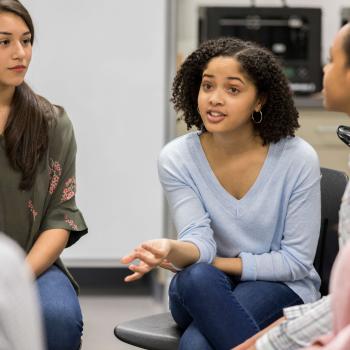Strategy Guide
Facilitating Participation with Silent Conversations

Grades
5 - 12
Author
Publisher
NCTE
Strategy Guide Series
Evidence-based Discussions
About this Strategy Guide
This guide introduces silent conversations, a collaborative learning technique that has students thinking, sharing, and reflecting about important questions—but through writing rather than talk.
Research Basis
Dialogue and conversation are cornerstones to our approaches in helping students try out and develop new ideas, but not all learners are equally comfortable or adept at participating in large- or even small-group verbal discussions. Silent conversations capitalize on the social nature of learning by asking students to share their thinking and to build from and reflect on the thinking of others, but they do so by allowing students the to use writing for additional time to think and refine their ideas.
Strategy in Practice
Preparation
- Using either teacher- or student-generated open-ended questions (4-5 is a good number), make a “discussion space” for each question. If students are able to be up and moving around the room, write each question at the top of a piece of chart paper and post them at intervals throughout the room. If students need to remain seated, write each question at the top of a piece of printing paper. (In this case, consider making multiple copies of each question so each student will have a question to respond to at all times.)
- Explain to students that this is a silent conversation. Instead of speaking to their peers as they respond to the questions and build from each others' ideas, they do so in writing. As in a spoken conversation, though, a key goal is response to previous ideas, not just presentation of something new.
- Distribute different colored pens/pencils to help keep track of the “speakers” in the conversation and/or ask students to put their initials after their comments. Encourage students to use evidence to support their assertions and to add supporting (or contradictory) evidence to the discussion already in progress when they get to a new question.
- Caution students against merely agreeing or disagreeing with a previous response. They need to elaborate on any such responses with a because statement that either offers up new evidence or presents an alternative view of the evidence already at hand.
The Discussion
- Set aside 15-20 minutes for the conversation and allow students a few minutes to interact with each question. If students are up and round the room, several students will be at a question at a time; if using single sheets for seated students, students can pass the questions down a row or around a table.
- Remind students to add new ideas and to build from previous ones as well.
- Announce when it is time for students to move to a new question or to pass their question sheet around.
- Allow for 2 or 3 passes through each question while students continue to add their thinking to the paper or chart paper.
Reflection
- After the silent conversation, allow time for students to look back at everything that was written in response to each question, but without writing anything new. Alternately, assign groups to look more closely at one of the questions and response spaces, with each group ultimately sharing to the rest of the class the most interesting and important points raised in response to the question.
- Facilitate reflection either with talk or in writing. Focus on questions such as these:
- How did your classmates build from one of your ideas?
- What’s an idea that changed the way you’re thinking about the text or topic?
- How was participating in a silent conversation different from a regular class discussion?
- What’s something you want to ask or add now that you’ve had additional time to think?
- Students might choose one of the questions as the beginning of a writing prompt. Post the conversations around the room and/or take photos of each set of responses and post them on the class wiki or website so students can refer to them easily.
